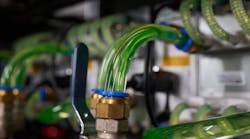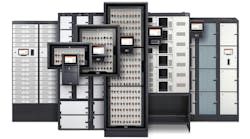Fission Forward: Next-Gen Nuclear Power Developments for the AI Data Center Boom
Key Highlights
- Oklo has achieved key milestones in fuel supply and power conversion, positioning its microreactor for early deployment in AI campuses.
- Constellation plans to extend and uprate existing nuclear units while exploring nearly 2 GW of new advanced nuclear at Calvert Cliffs to meet Maryland's rising energy demand.
- TerraPower's Natrium reactor cleared a major federal environmental milestone, advancing its path toward commercial operation as a flexible, dispatchable power source.
- TVA is pursuing a multi-track strategy involving various advanced nuclear technologies to support the increasing 24/7 load from hyperscalers like Google and Meta.
- Aalo Atomics is progressing toward factory-built, data-center-scale reactors, leveraging AI and fuel supply partnerships to accelerate deployment and commercialization.
As AI data centers drive unprecedented power demand, nuclear energy is rapidly reentering the industry conversation as a cornerstone of 24/7, carbon-free supply. From SMRs and microreactors to large-unit uprates and brownfield restarts, developers and hyperscalers are exploring a new generation of fission technologies aligned with round-the-clock compute growth. While each project faces steep licensing, fuel-supply, and construction milestones, together they signal a fast-shifting landscape for firm clean power.
This is the first edition of Fission Forward, an occasional Data Center Frontier feature tracking the key federal actions, utility plans, and reactor advances shaping the future of nuclear energy for digital infrastructure.
Oklo Advances Fuel Supply and Power-Conversion Milestones
Oklo notched two major steps forward on the path to deploying its first microreactor, signaling accelerating readiness across fuel, licensing, and long-lead procurement.
On Nov. 11, the U.S. Department of Energy approved a Nuclear Safety Design Agreement for Oklo’s Aurora fuel-fabrication facility at Idaho National Lab—an essential milestone toward establishing domestic HALEU and TRISO-class fuel supply for microreactors aimed at colocated, behind-the-meter loads such as AI campuses. The announcement follows Oklo’s September decision to pursue a $1.68 billion fuel-recycling facility in Oak Ridge, Tennessee, underscoring the company’s push to vertically integrate the advanced-fuel cycle.
Fuel availability remains the quiet schedule risk for non-light-water designs, and DOE has recently accelerated workstreams around HALEU production, criticality benchmarking, and supply-chain diversification to reduce reliance on Russian material. Federal movement here directly influences FOAK timelines for SMRs and microreactors expected to enter data-center procurement conversations later this decade.
Adding to this momentum, on Nov. 19 Oklo and Siemens Energy signed a binding contract for the design and delivery of the Aurora powerhouse’s power-conversion system. The agreement authorizes Siemens Energy to begin detailed engineering for a condensing SST-600 steam turbine, an SGen-100A generator, and associated auxiliaries—one of the major long-lead components needed to bring the Aurora unit online at INL. With site and fuel already allocated, securing turbine systems de-risks a key part of the supply chain and signals real execution capability for Oklo’s first commercial unit.
Siemens highlighted the fit between its proven industrial turbine technology and Oklo’s inherently safe, compact fast-fission design, while Oklo emphasized that leveraging commercial off-the-shelf power systems is central to shortening deployment timelines and reducing cost.
Microreactors in the 5–20 MW range remain the most “campus-sized” nuclear option in development for digital infrastructure. Oklo’s forward progress on both fuel fabrication and power-conversion procurement positions Aurora as one of the leading candidates for early deployment in AI-aligned, behind-the-meter configurations—pending licensing cadence and continued DOE support.
Constellation Explores Major Nuclear Expansion at Calvert Cliffs
On Nov. 4–5, Constellation outlined to Maryland regulators a broad slate of new generation options that includes life extensions and a 10% uprate at the existing Calvert Cliffs units, adding roughly 190 MW of additional output, as well as the potential development of nearly 2 GW of new advanced nuclear at the same site. The proposals are framed around fast-rising electricity demand across Maryland, driven by data center growth along the I-95 corridor and broader electrification needs.
In total, Constellation presented a roadmap for up to 5.8 GW of new generation and battery storage, including 800 MW of BESS and 700 MW of new natural gas, with nuclear positioned as the long-term backbone for firm, carbon-free power in the state.
Joe Dominguez, President and CEO of Constellation, told regulators:
Constellation already has invested over $1 billion of its own money on Maryland wind, hydro and 24/7 clean nuclear energy resources to power Maryland families and businesses for generations to come. Today, we announce an ambitious plan to make billions of dollars of new investments in Maryland without seeking any electricity rate increases, including options ranging from new natural gas to battery storage and nuclear energy. What is clear to us is that we must build and retain resources that produce abundant, reliable and clean power. The best way we know to do that is to make state-of-the-art investments in our state’s existing nuclear, hydroelectric and renewable energy resources to get them to operate better and longer, and then to build on top of that great foundation.
Constellation proposes to begin with 1.5 GW of fast-tracked projects, including 800 MW of battery energy storage and 700 MW of new natural gas generation to address short-term reliability needs. The remaining 4.3 GW represents longer-term investment at the Calvert Cliffs Clean Energy Center: extending both units for an additional 20 years beyond their current 2034 and 2036 license expirations, implementing a 10% uprate that would add roughly 190 MW of output, and pursuing 2 GW of next-generation nuclear at the existing site.
For Maryland, a state defined by a dense I-95 fiber corridor, accelerating data center buildout, and rising AI-driven load, the plan could be transformative. If Constellation moves from “option” to “program,” the company estimates that 70% of the state’s electricity supply could come from clean energy sources, positioning Maryland as a top-tier market for 24/7 carbon-free power.
TerraPower’s Natrium SMR Clears a Key Federal Milestone
On Oct. 23, the Nuclear Regulatory Commission issued the final environmental impact statement (FEIS) for TerraPower’s Natrium small modular reactor in Kemmerer, Wyoming. While not a construction permit, FEIS completion removes a major element of federal environmental risk and keeps the project on track for the next phase of NRC review. TerraPower and its subsidiary, US SFR Owner, LLC, originally submitted the construction permit application on March 28, 2024.
Natrium is a sodium-cooled fast reactor producing roughly 345 MW of electric output, paired with a molten-salt thermal-storage system capable of boosting generation to about 500 MW during peak periods. The design combines firm baseload power with flexible, dispatchable capability, an attractive profile for hyperscalers evaluating 24/7 clean energy options in the western U.S.
The project is part of the DOE’s Advanced Reactor Demonstration Program, intended to replace retiring coal capacity in PacifiCorp’s service territory while showcasing advanced fission technology. For operators planning multi-GW AI clusters in the Mountain West, Natrium represents one of the most mature next-generation reactor pathways under active development.
TVA Positions Itself as an Advanced Nuclear Platform for Big Tech
In late October, Reuters detailed the Tennessee Valley Authority’s multi-track strategy across advanced nuclear technologies—including Kairos, NuScale, GEH’s [GE Hitachi Nuclear Energy] BWRX-300, and even early-stage fusion pilots—explicitly linking the effort to rising 24/7 load from Google, Meta, and xAI. TVA’s scale, balance sheet strength, and vertically integrated structure allow it to take earlier-stage technology risk than most U.S. utilities.
As these projects move beyond proof-of-concept phases, TVA is expected to anchor a wider set of utility-backed PPAs and joint-venture structures that give hyperscalers firm, nuclear-supported power procurement options without locking them into a single reactor vendor. By pursuing both utility-owned deployments (BWRX-300) and developer-owned PPA models (Kairos, NuScale), TVA is effectively broadening the pathways by which dispatchable, carbon-free capacity can be matched to long-term compute growth.
Palisades Restart Gains Momentum as DOE Funding Advances
The Department of Energy issued additional funding in mid-September to support Holtec’s restart of the 800 MW Palisades plant, the first attempted commercial nuclear revival in the United States, keeping a potential Q4 2025 restart on track. The NRC granted its environmental approval earlier this year, and both DOE and national media have increasingly linked the project to accelerating AI and data-center power demand.
For MISO and PJM-adjacent regions facing rapid load growth, brownfield restarts and uprates like Palisades represent the fastest near-term pathway to new carbon-free megawatt-hours at scale.
Westinghouse/AP1000 Build Program Gains Geopolitical Momentum
In late October, multiple reports detailed a U.S.–Japan–backed initiative outlining a large-scale AP1000 reactor build program with Westinghouse, framed in part around meeting rising AI-era industrial and data-center demand. While key details are still emerging, the early signals point to significant political support behind a new wave of gigawatt-scale nuclear development.
In October 2025, the U.S. Department of Commerce formalized a strategic partnership with Westinghouse (co-owned by Brookfield Asset Management and Cameco) to deploy an initial fleet of AP1000 reactors valued at a minimum of $80 billion in the United States.
Parallel to this effort, a broader U.S.–Japan investment framework earmarks up to $550 billion in Japanese capital for U.S. energy infrastructure, including nuclear projects. Major Japanese firms such as Mitsubishi Heavy Industries, Toshiba Group, and IHI Corporation are positioned as key supply-chain contributors for AP1000 deployments.
For multi-gigawatt AI “factory” clusters, standardized large-unit builds at existing nuclear sites or brownfields could become increasingly viable ... assuming cost controls, repeatable delivery models, and federal-industry alignment continue to strengthen.
Aalo Atomics Accelerates Toward Data Center-Scale Demonstration
Austin-based Aalo Atomics has continued to make strategic moves that reinforce its position as a nuclear provider built for the AI era. The company’s recent milestones include:
A landmark collaboration with Microsoft: Aalo is using Microsoft’s Generative AI for Energy Permitting Solution Accelerator and agentic AI workflows to streamline its regulatory, licensing and operational processes. Says CTO Yasir Arafat:
“So far, we have tackled three of the most impactful challenges in the nuclear industry – using AI to simplify, accelerate, and ultimately transform how complex energy systems are licensed, built and operated at scale.”
Securing fuel supply traction: Aalo signed a commercial contract with Urenco for low-enriched uranium (LEU) in July 2025, marking one of the first times a U.S. advanced reactor company has sourced commercial-grade fuel outside the heavily constrained HALEU stream.
Demonstration reactor progress: Aalo broke ground on its Aalo-X 10 MWe experimental reactor at Idaho National Laboratory (INL) in August 2025, aiming for criticality by July 4, 2026. The reactor will be factory-built, sodium-cooled and serve as the pathfinder for its 50 MWe “Aalo Pod” commercial product designed for data centers.
Deployment scale vision: The Aalo Pod concept — five factory-built reactor modules delivering ~50 MWe — is purpose-built for colocated, data-center adjacent power supply. The company positions this architecture as a competitive, deployable alternative to large legacy reactors or standard SMRs.
Why This Matters for Data Center and AI Infrastructure Stakeholders
Aalo is targeting a niche that sits right at the intersection of hyperscale compute loads and firm, carbon-free power. By focusing on modular, factory-manufactured nuclear plants, Aalo is aiming to deliver a “just-for-data-centers” power architecture: smaller footprint, faster deployment, and direct adjacency to compute loads.
The fuel deal, AI/perm-tech partnership, and early build at INL all signal that the company is moving beyond concept and into execution.
Key Risk/Exit Items to Watch
- Can Aalo hit its July 2026 criticality target for Aalo-X? Demonstration success will be a strong validation point.
- Will commercial delivery of the Aalo Pod (50 MWe) follow in the 2029 time-frame as promised? That matters for data-center admissions of nuclear-adjacency.
- Regulatory and licensing progression: While the DOE’s Reactor Pilot Program affords streamlined routes, achieving grid-connection and data-center PPA readiness will require tight regulatory execution.
- Manufacturing and supply-chain ramp: Factory-building reactors at scale for data-center loads remains novel — securing modules, turbines, cooling systems, fuel logistics will be critical.
- In short: Aalo Atomics has moved from “vision” to “visible execution,” and for data-center operators looking for clean-firm power options adjacent to compute, the company is one of the most advanced “nuclear-for-AI” developers to track.
Bottom Line for AI-Hungry Operators
For developers and operators planning large AI campuses, the most actionable nuclear pathways in the near term remain brownfield restarts and uprates - including Palisades, TMI-1, and the Calvert Cliffs uprates - as well as long-duration PPAs with the existing fleet. These options represent the fastest route to adding meaningful volumes of 24/7 carbon-free energy this decade.
Next-generation technologies - TVA-anchored SMR platforms, Oklo-class microreactors, and advanced fast-reactor designs - hold promise for modular and edge-aligned deployments. But their viability hinges on fuel availability, licensing cadence, and FOAK construction timelines. These systems should be viewed as 2030s opportunities, worth watching but not yet bankable for near-term AI load planning.
At Data Center Frontier, we talk the industry talk and walk the industry walk. In that spirit, DCF Staff members may occasionally use AI tools to assist with content. Elements of this article were created with help from OpenAI's GPT5.
Keep pace with the fast-moving world of data centers and cloud computing by connecting with Data Center Frontier on LinkedIn, following us on X/Twitter and Facebook, as well as on BlueSky, and signing up for our weekly newsletters using the form below.
About the Author

David Chernicoff
Matt Vincent
A B2B technology journalist and editor with more than two decades of experience, Matt Vincent is Editor in Chief of Data Center Frontier.



